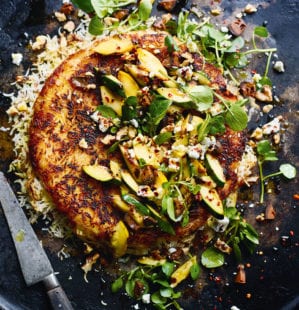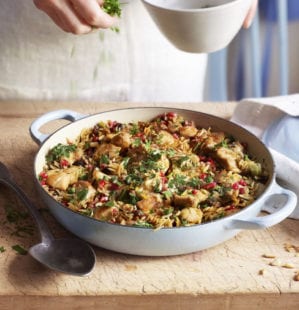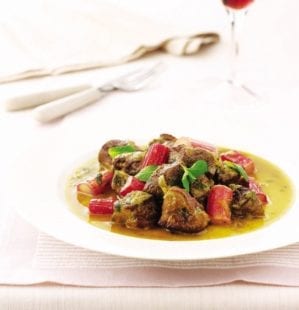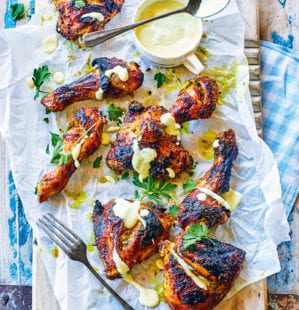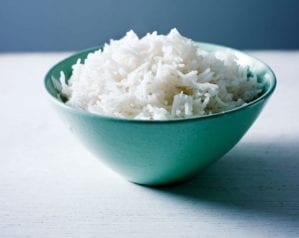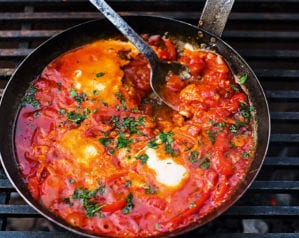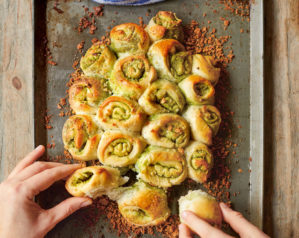
Tahdig (crispy Persian rice)
- Published: 2 Mar 23
- Updated: 14 Nov 24
Learn how to achieve the perfect tahdig – the highly sought after crispy-chewy base created when you cook Persian rice. Despite tahdig’s seeming simplicity, it requires keen senses, patience and know-how. Chef Yuma Hashemi of The Drunken Butler in London is here to guide you.
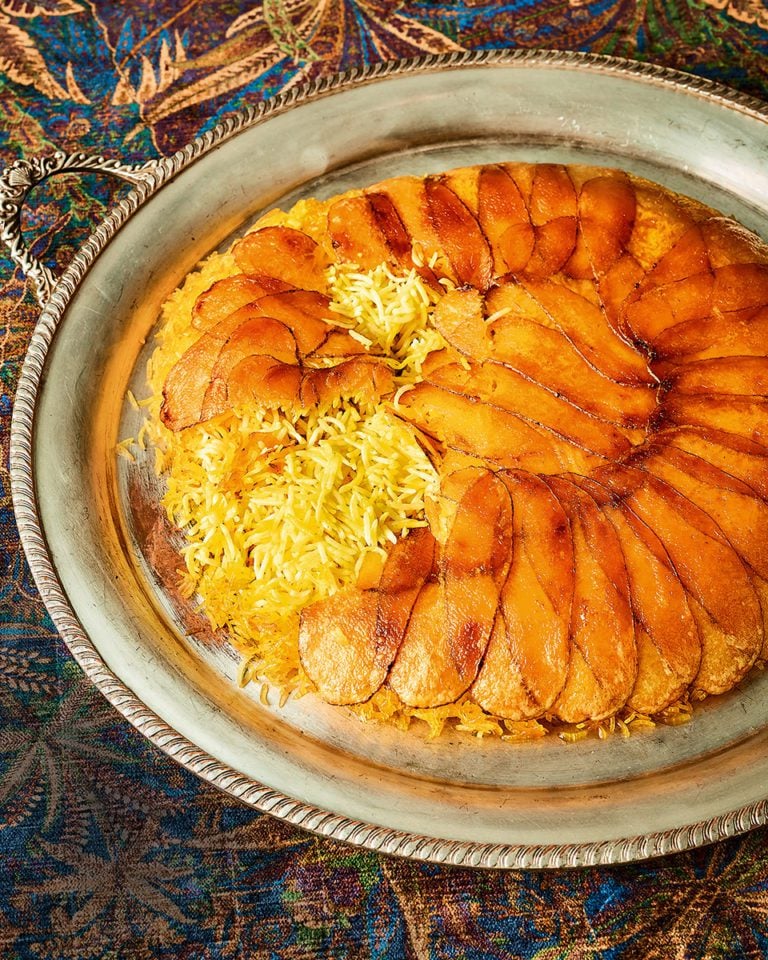
Try serving this tahdig alongside Persian chicken with spiced yoghurt
-
Serves 4-6
-
Hands-on time 25 min, plus overnight soaking. Simmering time 1 hour 10 min
Ingredients
- 500g basmati rice
- 1 tsp salt, plus sea salt flakes
- Large pinch saffron
- 50g vegetable oil, plus 1 tbsp extra to drizzle
- 50g unsalted butter
- 2 large floury potatoes
Specialist kit
- Mandoline (optional)
Method
- Wash the basmati rice several times until the water runs clear (see Know How), then drain and put in a big container. Cover with lots of fresh water – around 3 times as much water as rice. Add the salt, then cover and chill overnight.
- The next day, use a pestle and mortar to grind the saffron with a pinch of sea salt flakes into a bright red powder. Pour in 2-3 tbsp hot water and mix to create a bright red saffron water.
- Drain the rice and wash again (see previous page), then put it in a large saucepan and cover with lots of cold water. Add 2 pinches of salt, then stir in 1 tbsp of the saffron water – it should turn the water orange. Bring to the boil over a medium-high heat, then cook the rice for 1-2 minutes until the grains have doubled in size (they’re only parboiled now, so don’t worry about the firmness). Drain, then cool under cold running water to halt the cooking. Leave to drain, stirring 1 tbsp veg oil into the rice.
- Mix the butter and oil in a small pan, drizzling in the rest of the saffron water, then gently heat until the butter has melted. With a pastry brush, liberally coat a deep frying pan (around 25cm, with a lid) with the mix.
- Use a mandoline or sharp knife to finely slice the potatoes, trying to ensure they’re the same thickness. Lay the slices in the pan, overlapping each other,
until the base is fully covered (you may not need all the potato slices). Brush the potatoes with lots more butter mixture, then put the parboiled rice on top, ensuring it’s flat and level. - Cover the pan with the lid, ensuring it’s tightly sealed, then put over a low heat. Cook for about 1 hour 10 minutes. The exact time will depend on many factors, so after 1 hour, start hovering around the tahdig and keep an eye (and nose) on it. Lift the lid slightly and smell the rice – it’s ready when it smells toasty and nutty (see Yuma’s tips).
- Remove the pan from the heat. Put your serving platter upside down on top of it (make sure your platter is bigger than the pan!). Wearing oven gloves or holding tea towels, carefully but confidently upturn the pan and platter in a swift steady motion, then lift the pan away to reveal the tahdig. Brush the crispy top liberally with more of the butter and oil mixture, then leave everyone to dig in and fight over the crispy bits.
- Recipe from March 2023 Issue
Nutrition
- Calories
- 475kcals
- Fat
- 13.5g (4.9g saturated)
- Protein
- 8.4g
- Carbohydrates
- 78.9g (0.7g sugars)
- Fibre
- 2.2g
- Salt
- trace
delicious. tips
Yuma’s top tips for perfect tahdig…
Use a heavybottomed, good quality non-stick pan.
Making sure the slices of potato are all the same thickness is more important than getting them as thin as possible, which is why a mandoline is useful.
Be liberal with the oil and butter when brushing – along with the saffron, it’s where the majority of the flavour comes from.
The temperature you cook at impacts the overall cooking time, so it’s a bit of a guessing game for the first one you make. If you think of the heat of your hob on a scale of 1-9, you want to aim for a 3. The cooking can take anywhere between just over an hour and an hour and a half.
You need to use your nose to work out when the tahdig is ready.
Lift the lid slightly and smell – it’s ready when you get the toasty, nutty aromas
of brown butter. If it’s not quite there, cook it for 10 minutes more; if it smells bitter, you’ve burnt your tahdig!As soon as the tahdig is ready, invert the plate over the pan, hold it on and flip over to turn out the rice onto your serving platter. Remove the pan quickly. If you leave it on top for too long, the steam will get trapped around the crust and it’ll turn soggy.
Finally, if you do burn your tahdig, don’t worry – the rice will still be
perfectly good and delicious to eat. You’ll miss out on the crust,
but you’ll know for next time you need to reduce the temperature or start checking the smell earlier.Tahdig is a dish of slow-cooked basmati rice. The word literally means ‘bottom of the pot’, referring to the caramelised crispy base that develops during cooking. The rice is served as a side to meaty stews – but ask any Iranian and they’ll tell you it’s the tahdig crust, not the stew, everyone goes for first.
Take your time washing the rice, says Yuma. There are three stages…
Wash First, submerge the rice in plenty of cold water. Shape your hand into a claw and, with a circular motion, start swishing the rice around. Once the water turns chalky, drain the rice and repeat the process until the water remains clear. Yuma recommends washing the rice 10 times (yes, really!) to ensure you’ve got rid of as much starch as possible.
Soak Next, to get rid of even more starch, Yuma soaks his rice overnight in plenty of cold water and – crucially – a teaspoon of salt. This kicks off the seasoning process but also helps soften the grains so they absorb more water.
Drain and parboil You now drain the rice, wash it again (for good measure), then boil it with a little saffron and more salt for just a few minutes. As soon as the grains double in size, the rice is drained and rinsed under cold water to halt the cooking process. Now it’s time to build the tahdig.
Buy ingredients online
Rate & review
Rate
Reviews
Subscribe to our magazine
Food stories, skills and tested recipes, straight to your door... Enjoy 5 issues for just £5 with our special introductory offer.
Subscribe
Unleash your inner chef
Looking for inspiration? Receive the latest recipes with our newsletter

